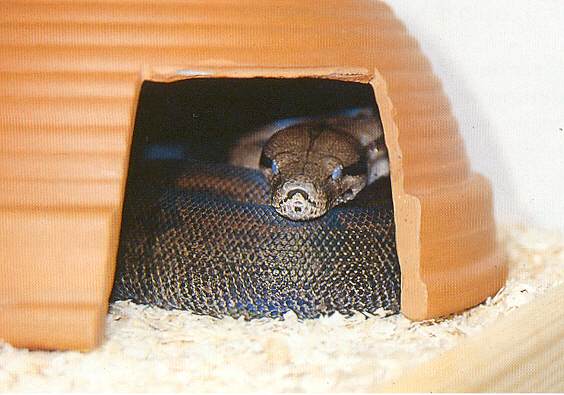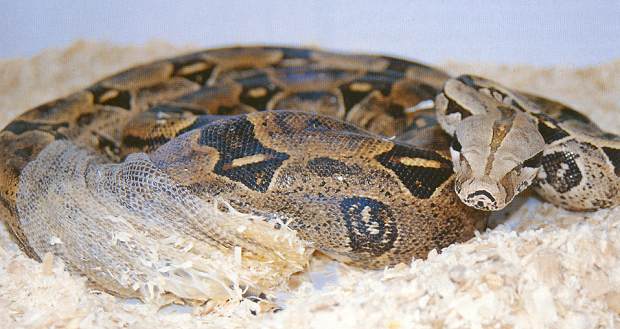- ! ! ! ! ! ! ! ! ! ! ! ! ! Latest Updates
- ! ! ! ! ! ! ! ! ! ! ! ! ! Latest Updates
- ! ! ! ! ! ! ! ! ! ! ! ! ! Latest Updates
- Home
- Boa constrictor subspecies
- Boa constrictor - Interesting Facts
- More boa information
- Boa Gallery
- Boas for Sale
- Contact
How often does a boa shed?
There is no generally valid answer for this question, as there are several factors that play a role in this. The most important factor is the growth rate of the snake, which in turn mainly depends on the food intake.
The more you feed, the shorter the shed cycles of your boa will become.
The next factor is the temperature, at which the snake is kept. The lower the temperature is, the slower the metabolism of the animal, which influences the frequency of sheds. The age of the snake also plays a role. The younger the snake is, the shorter the intervals between sheds.
Due to the high growth potential of young snakes, neonates and hatchlings can shed up to 9 times a year, if fed intensively (which should not be practiced that way).
In adult boas, about four to five sheds per year are normal.
Vitamin A and Shedding
This substance plays an important role in the shedding process. It is even possible (and practiced by vets if called for by the situation) to trigger shedding by administering this vitamin. Vitamin A belongs to the group of vitamins that are soluble in fat. Overdoses are therefore not excreted, but instead are retained in the fat tissue of the animal.
Well-meaning keepers have accidentally gotten their adult (mature) animals up to 15 sheds within a period of 18 months through overdoses of vitamin A. For clarification: Even a few overdosed applications are sufficient to cause this effect, and it can take a year and a half until the retained vitamin A has been reduced to a normal level.
Afterwards, the spine and ribs become visible, as the constant sheds completely emaciate the reptile. Therefore, extreme caution should be taken when administering vitamins, especially if the snake has put its system into “save” mode, due to expired frozen prey or malnourished prey animals. In that case, even a normal dose of vitamin A hits like a hammer.
 Boa c. amarali in shed (notice the "milky" eyes)
Boa c. amarali in shed (notice the "milky" eyes)
The Shedding Process
If a new layer of skin becomes necessary because of growth or other factors, such as wear, skin injuries or diseases, the new layer of skin (very simplified) forms underneath the old one.
A film of liquid develops between the two layers of skin, which later makes it easier for the animal to cast its skin. This storage of fluid is the reason why the eyes of the reptile become cloudy, and the colors of its scales appear pale.
Boa constrictor shedding | Boa constrictor shedding problems | Boa constrictor shed its skin | Boa constrictor is opaque | how often do boa constrictor shed | boa bad shed
The behavior of the snake also changes. In this phase, the animal is inactive, is not seen crawling around, and food is often (not always) rejected. Many specimens also tend to be more aggressive when disturbed, which may be due to their limited perception, caused by the decreased ability to see.
When the new layer of skin has developed sufficiently, all but a small rest of the film of liquid disappears. The eyes of the snake become clear again, and the colors brighten up again. At that point, some beginning keepers assume that the snake has already shed and eaten the skin right after, as it was not to be found anywhere in the enclosure.
In reality, the actual shedding occurs one to three days later, and the shed skin is not eaten.
The reptile feels exactly when the right time has come for it to shed the skin. It then rubs and pushes its nose on rough objects in the enclosure, until the old layer of the skin begins to tear by the lips. With skillful rubbing on suitable objects, the animal casts its old skin in a way that eventually leaves the same rolled up like a fresh contraceptive (you may forgive us for this pertinent analogy) in the enclosure. Both eye caps and cloaca are well recognizable on the shed skin.
This should really be a standard procedure, which is why we cannot follow keepers who brag about the fact that their animal has shed nicely. Dear boa - keepers: This is self-evident, and everything else is a result of inadequate housing conditions, which we will discuss now.

